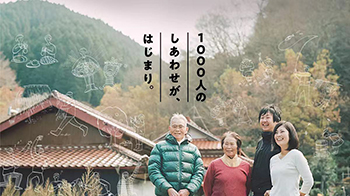Japan-based writer and traveller, specialising in design, lifestyle and travel journalism. Ron previously served as an editor of MING Magazine, ELLE Decoration and CREAM.
Japan’s countryside is facing the pressing issue of an aged society. The local population is decreasing. Life is becoming less and less convenient here. All these seem inevitable. But there are also young people who decided to go back to the countryside out of their nostalgic sentiment. They don’t want the land and people that nurtured them to be forgotten by Japanese society. Bearing such hope, they return to their home after their venture around the world.
Itsuki is a small village situated in Kumamoto Prefecture, Japan, covering an area of around 250 square kilometres. The village has only about 1,000 local residents, which makes it the smallest village in Kumamoto Prefecture in terms of population. Surrounded by mountains, the village actually enjoys a rather large area and its tribes are scattered in several plains among the mountains. Itsuki is therefore known as a village lying in the heart of nature. Several years ago, Kumamon, the tourism ambassador from Komamoto, came to the Kawabegawa River in Itsuki and walked on the 66-metre-tall Kobaebashi Bridge just like other visitors to the attraction. With both of his legs strapped with the safety robes, Kumamon did a bungee jump from the bridge. The Kobaebashi Bridge was originally a place for local residents to hide away from the summer heat and a destination to appreciate maple trees during autumn. The increase of tourists to the Kobaebashi Bridge has made Itsuki more lively during peak seasons.
However, Itsuki will return to its tranquil state in ordinary days, with its mountains covered in green. Over half of the local residents in the village are over 65 years old, most of whom are in the line of forestry. Every family here farms to support themselves since the supermarkets are very far away. It is also very difficult to buy groceries here. For example, it is hard to find construction materials, appliances, water supply, and utility maintenance in Itsuki. That is why the villagers here are all equipped with a diverse skill set. They know how to repair their homes and how to fix their water pipes, etc. Villagers at Istuki basically live off the land in their own ways.

Nozomi Tsuchiya was born and raised in Itsuki. Since little, she has always loved this small village where there is a strong sense of community. After leaving Itsuki for college, Nozomi participated in a series of events organised by Fumidas that aimed to help young talents engage in revitalisation of communities. Inspired by other young entrepreneurs, Nozomi started to brew the idea of helping Itsuki. After graduating from college, she decided to quit her job in the media industry and joined ETIC., an NPO specialised in regional revitalisation. Nozomi worked at ETIC. for three and a half years and returned to Itsuki with her husband Masaki Hino, as well as her rich experience in business planning. Together, the married couple founded Hizoe.
Hizoe is the name of a tribe that Nozomi had lived in. There are two tribes in Itsuki: Hiate (In Japanese: 日当) and Hizoe (In Japanese: 日添 ). In Japanese, Hiate means places where the sun shines upon while Hizoe means places where the sunlight can’t reach. By the first impression, Hizoe might sound ominous. But Nozomi and Masaki believe that when there are places where the sun shines there would always be places the sun can’t reach. In other words, the two concepts can’t exist without each other. “Zoe” (In Japanese: 添) also has the meaning of companion and accessory in Japanese. “Finding the value of local people and villages and accompanying countryside” happens to be Hizoe’s concept.
Hizoe’s business plans are very diverse. Simply put, Hizoe’s business plans aim to connect local residents in villages with people from other places. In addition, Hizoe tries to boost local villagers’ sense of happiness by getting more attention from the outside. Hizoe’s Café Minamoto, for example, has become a social venue where local villagers can meet visitors from other places. The foods served at Café Minamoto such as vegetables, fruits and rice are all fresh produces from local farmers. Meat, on the other hand, is supplied by hunters in the village. In addition, Hizoe also provides services in product development. All the products from their initiative can be sold through the vending machines in the café. Hizoe also provides assistance in the design of brand logo, name cards, leaflets, etc. It is Hizoe’s hope to promote Itsuki through the village’s catering business and increase villagers’ business confidence through the income they make with the products they sell. The vending machines also sell food and other groceries that are hard to find in the village, bringing convenience to local life.
There are quite a number of villages in Japan that are similar to Itsuki. There are important values that are worthy of appreciation. As a matter of fact, every city and every region in the world has its own traditions. Hizoe is still in its initial process but it might be a great regional revitalisation reference for rural areas in Japan. And the lesson that we can learn from Hizoe is that we need to take action to appreciate and preserve the traditional value and culture that a place has.